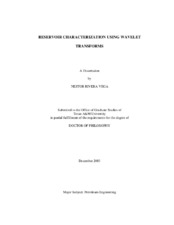| dc.description.abstract | Automated detection of geological boundaries and determination of cyclic events controlling deposition can facilitate stratigraphic analysis and reservoir characterization. This study applies the wavelet transformation, a recent advance in signal analysis techniques, to interpret cyclicity, determine its controlling factors, and detect zone boundaries. We tested the cyclostratigraphic assessments using well log and core data from a well in a fluvio-eolian sequence in the Ormskirk Sandstone, Irish Sea. The boundary detection technique was tested using log data from 10 wells in the Apiay field, Colombia.
We processed the wavelet coefficients for each zone of the Ormskirk Formation and determined the wavelengths of the strongest cyclicities. Comparing these periodicities with Milankovitch cycles, we found a strong correspondence of the two. This suggests that climate exercised an important control on depositional cyclicity, as had been concluded in previous studies of the Ormskirk Sandstone.
The wavelet coefficients from the log data in the Apiay field were combined to form features. These vectors were used in conjunction with pattern recognition techniques to perform detection in 7 boundaries. For the upper two units, the boundary was detected within 10 feet of their actual depth, in 90% of the wells. The mean detection performance in the Apiay field is 50%.
We compared our method with other traditional techniques which do not focus on selecting optimal features for boundary identification. Those methods resulted in detection performances of 40% for the uppermost boundary, which lag behind the 90% performance of our method.
Automated determination of geologic boundaries will expedite studies, and knowledge of the controlling deposition factors will enhance stratigraphic and reservoir characterization models. We expect that automated boundary detection and cyclicity analysis will prove to be valuable and time-saving methods for establishing correlations and their uncertainties in many types of oil and gas reservoirs, thus facilitating reservoir exploration and management. | en |


